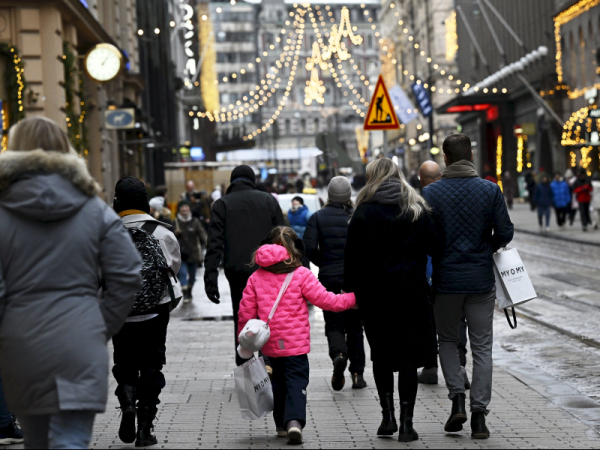
People did last-minute holiday shopping on 23 December 2023. This year promises to add hundreds of euros to the purchasing power of the average wage earner, according to experts interviewed by YLE. It will take several years, though, to fully recoup the losses incurred in recent years. (Vesa Moilanen – Lehtikuva)
- Next Article Inflation accelerated to 3.6% in Finland in December
THE PURCHASING POWER of Finnish wage earners has eroded by thousands of euros in the past couple of years.
“The purchasing power of a person earning around 3,800 euros a month was six per cent lower last year than in 2020. The purchasing power has practically fallen by a total of 2,000 euros in three years,” Mikael Kirkko-Jaakkola, the chief economist at the Taxpayers’ Association of Finland, stated to YLE on Monday.
The erosion came to a halt last year, though, as wages began to increase and the euro-denominated bonuses agreed in recent collective bargaining talks were paid out.
“Inflation was at 3.6 per cent from December 2023 to December 2022. Wages, in turn, had risen by as much as 4.5 per cent by the end of September. It’s therefore likely that wages rose more than prices,” remarked Hannu Nummiaro, an economist at Lähi-Tapiola.
The situation improved especially for earners without any outstanding debt because interest rates accounted for most of the rise in consumer prices in December. The reversal did not suffice to entirely offset the full-year rise in consumer prices, which came in at 6.2 per cent, according to Statistics Finland.
“Inflation for the full year was 6.2 per cent, which is why purchasing power fell in annual terms. Inflation slowing down especially at the end of the year meant that the purchasing power of wage earners started to turn in a better direction,” said Kirkko-Jaakkola.
Although wage earners are set to recoup some of the losses this year, it will take some time before purchasing power is restored at pre-pandemic levels.
“Slowing inflation will raise real wages and the drop in social security contributions will alleviate the tax burden. Purchasing power will turn around and rise by around two per cent. In annual terms, the average earner will see the purchasing power of their disposable income increase by about 750 euros,” he commented.
There is nonetheless a long way to go until purchasing power has recovered to pre-pandemic levels,” according to Kirkko-Jaakkola.
“This year, we’ll make up roughly for the erosion that took place last year. Purchasing power will still stay at a lower level than in the coronavirus-disrupted year that was 2020,” he told. “It’ll take three to four years until we’re at the same level than before the dip in purchasing power started.”
Aleksi Teivainen – HT
- Next Article Inflation accelerated to 3.6% in Finland in December
Source: www.helsinkitimes.fi
